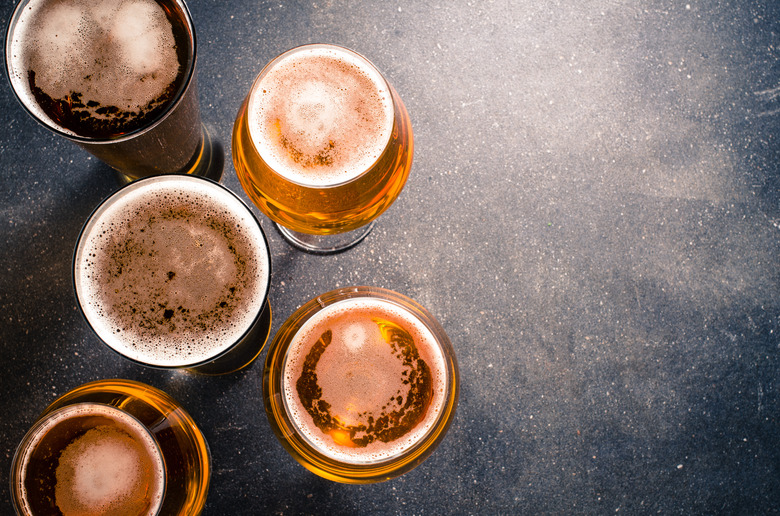How To Find The Mass Of A Liquid
The easiest way to find the mass of anything is to weigh it. You're actually measuring the force of gravity on the object, and technically, you should divide the weight by the acceleration due to gravity to get the mass. For most applications, though, weight and mass are essentially equivalent. Now suppose you don't have a scale. Can you still find the mass of a particular liquid? Yes, if you know what the liquid is, you can find its mass by measuring its volume and looking up its density. If you don't know what the liquid is, you can find its density by measuring its specific gravity with a hydrometer.
TL;DR (Too Long; Didn't Read)
Since **density = mass/volume**, you can find the mass of a specific amount of a liquid if you know its density. You can look up the densities of known liquids in a table. If you have a mystery liquid, you can measure its density with a hydrometer.
Weighing a Liquid
Weighing a Liquid
You can place a solid object directly on a scale, but a liquid always has to be in a container, and the container has weight. If you have a certain volume of a liquid in a beaker and you want its mass/weight, you must first find the weight of the empty beaker. You could weigh the liquid, pour it out of the beaker, and then weigh the beaker and subtract its weight from the weight of the beaker-plus-liquid. This method is inaccurate, though, because some liquid would remain in the container. A more accurate method is to place the beaker on the scale, record the weight and then pour in the liquid and record the new weight.
Most scales have a tare setting, and when you press it, it zeros the scale. This feature makes it easy to weigh a liquid. If you have a tare button on your scale, put the empty container on the scale and press tare. When the scale displays zero, pour in the liquid. The new reading is the weight of the liquid.
Calculating Mass From Density
Calculating Mass From Density
Every liquid has a characteristic density (D), which is defined as the ratio of its mass (m) to its volume (v). Mathematically:
\(D=\frac{m}{v}\)
If you know what liquid you have, you can look up its density in a table. Once you know that, all you have to do to find the mass of the liquid is to measure its volume. Once you know density and volume, calculate mass using this relationship:
\(m=Dv\)
Density is often given in units of kilograms/meter3. When you're measuring small quantities, it's more convenient to use grams and cubic centimeters, so the following conversion is useful:
\(1\frac{\text{kg}}{\text{m}^3}=0.001\frac{\text{g}}{\text{cm}^3}\text{ and }1\frac{\text{g}}{\text{cm}^3}=1,000\frac{\text{kg}}{\text{m}^3}\)
Example
Example
**What is the mass of 2 liters of acetone?**
Looking up the density of acetone in a table, you find it to be 784.6 kg/m3. Before making the calculation, convert the volume of liquid you have on hand to cubic meters using the conversion 1 liter = 0.001 cubic meters. Now you have all the information you need:
2 liters of acetone weighs:
\((784.6\text{ kg/m}^3)(0.002\text{ m}^3)=1.57\text{ kg}=1570\text{ g}\)
Finding Density Using a Hydrometer
Finding Density Using a Hydrometer
The specific gravity of a material is a dimensionless unit you obtain by dividing the density of the material by that of pure water at 4 degrees Celsius. If you have a mystery liquid, you can find its mass by measuring its specific gravity with a hydrometer. This is a glass tube with a bubble on the bottom. You fill the bubble with the liquid and place it in water. Depending on its density, the hydrometer bubble will sink far below the surface of the water or float close to the surface. You can read specific gravity, usually in gm/cm3, from the scale on the side of hydrometer. It's the mark that just touches the surface of the water.
Once you know specific gravity, you also know density, because you just multiply specific gravity by the density of water, which is 1 gm/cm3, to get density. You can then find the mass of a specific volume of the liquid by multiplying its density by the volume of the liquid you have.
Cite This Article
MLA
Deziel, Chris. "How To Find The Mass Of A Liquid" sciencing.com, https://www.sciencing.com/find-mass-liquid-4479115/. 6 November 2020.
APA
Deziel, Chris. (2020, November 6). How To Find The Mass Of A Liquid. sciencing.com. Retrieved from https://www.sciencing.com/find-mass-liquid-4479115/
Chicago
Deziel, Chris. How To Find The Mass Of A Liquid last modified March 24, 2022. https://www.sciencing.com/find-mass-liquid-4479115/
